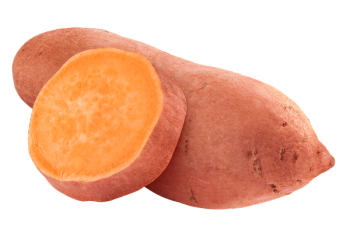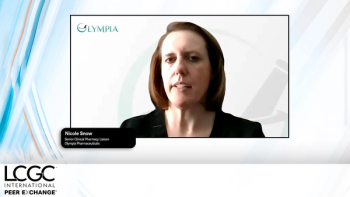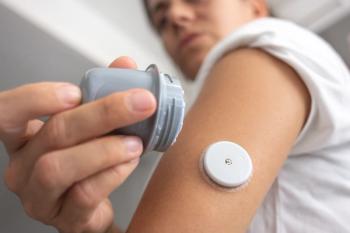
E-Separation Solutions
- E-Separation Solutions-04-12-2010
- Volume 0
- Issue 0
LC–MS
With LC–MS continuing to make headway into application areas previously reserved for other techniques, the growth of this lab workhorse technique shows no sign of slowing down.
With LC–MS continuing to make headway into application areas previously reserved for other techniques, the growth of this lab workhorse technique shows no sign of slowing down.
Joining us for this discussion are Ian Jardine and Iain Mylchreest of Thermo Fisher Scientific; Robert Classon of Shimadzu Scientific Instruments, Inc.; William C. Schnute of Dionex Corporation; and Michael P. Balogh of Waters Corporation.
What new developments in LC–MS have you seen so far this year?
Jardine and Mylchreest: Interesting new sample preparation techniques, such as analyte preconcentration using immunoaffinity techniques and in-line sample preparation forenvironmental applications. Also, the development of high-resolution andaccurate mass systems into the rapid screening and quantitativeapplications.
Classon:There are a couple of areas that seem to be driving innovation. Oneis the area of component identification. Everyone wants to know whatsome peak might be, especially if it is a contaminant or a metabolite.As good as mass spectrometers have become, they still have somedifficulty putting a name onto a peak. Mass accuracy has progressed tothe point where you can get to 1 ppm accuracy, but you still may have tosort through dozens of possible elemental compositions that might havethe same mass, but there is still some human interpretation required tomake sense of the results. I see that process becoming more automatedand less arbitrary in the future, partly because of better software andpartly because of better use of multiple fragmentation levels along withbetter spectral accuracy for interpretation.
A second significant area is getting the sensitivitydown a couple more orders of magnitude. In the proteomics world, thehigh abundance proteins are well-known. To get down to the lowabundance biomarkers that are in the pg/mL range, some new techniquesare necessary. One promising area is the use of nanoparticles toextract, concentrate, and preserve low abundant proteins from biologicalfluids. It may allow practitioners to quickly and easily get low enoughin terms of detection to finally discover what the key compounds are inthe biological soup we have for samples.
Schnute:On the LC side there have been introductions of new rapid separation pumps, including new splitless nano-flow pumps. The pumps have higher pressure limits at higher flows with better specifications for reproducibility and low noise. For the MS, the instrumentation has increased mass stability and accuracy, and there are several new higher resolution units that have captured the interest of the research and discovery markets. There are also developments on the MS side for instrumentation with expanded dynamic range, which will give broader coverage in quantitation.
Balogh:Strictly speaking genuinely "new developments" are few and far between from year-to-year. Of great interest to practitioners perhaps are those that rapidly gain staying power and show promise of developing quickly into highly useful tools. We have seen fundamentally sound technologies returning in modern engineered form matched to cutting edge tools such as atmospheric pressure GC (APGC) plugging into high resolution accurate mass spectrometers with ion mobility, ostensibly designed for LC ESI, with equal ease and performance expectations. Likewise simple, inexpensive thermal desorption tools such as atmospheric solids analysis probes (ASAP) being used with the same instruments as a means to ionize solid (and liquid) final form samples with little or no sample preparation or dilution. The success of these tools at the high end is already looking to filter into the benchtop tools found in most labs.
Which industries currently benefit the most from the use of LC–MS?
Jardine and Mylchreest:Pharmaceutical, food, environmental, clinical, academic, and government research benefit the most (especially proteomics and metabolomics in biology research).
Classon:Historically it was pharmaceuticals that got the most from LC–MS.From drug discovery to metabolism and dosage studies, to final productanalysis, LC–MS was a natural fit with pharmaceuticals. More recently, wehave seen a lot more interest in everything from glycomics andlipidomics to metabolomics. The applications base is broadening andevery day researchers are pushing the technologies of mass spectrometryinto new areas.
Schnute:Starting out, I would say that the pharmaceutical industry is still the big user of LC–MS. The specificity and selectivity that LC–MS offers for confirmation is a mainstay of the industry. Add that Q/A can be done quickly and reliably, and quantitation sensitivity — especially with MS-MS — can take you into the ppt and beyond range, it is the analytical method of choice.
Another area that benefits from LC–MS is the environmental market. When dealing with the trace (and sometimes not so trace) levels of analytes of environmental concern in matrices of air, soil, sludge, drinking water, ground water, and wastewater, etc., LC–MS brings a lot to the table. The selectivity of columns with the ability to deal with extracts or direct injection for analyses of a broad range of compound types and concentration ranges makes LC–MS a popular technique for environmental analysis.
Balogh:I see this as at least a two-dimensional question. On one side the advances in such tools as ion mobility and increased resolution quadrupole time-of-flight (QTOF) hybrids have clearly enabled researchers at the leading edge of analysis. Whether dealing with cellulosics for use in biofuels, furthering proteomics, or differentiating asphaltenes in petroleomics these often start with very little prior knowledge and complex samples. On the other hand, understanding in these areas ultimately filter to everyday bench-level practice just at different rates since the underlying LC–MS tools have similar capabilities.
What is the LC–MS application area that you see growing the fastest?
Jardine and Mylchreest:Protein quantitation in biological systems in the research area and inapplied areas food safety testing.
Classon:There are so many, it is difficult to choose just one. I would saythat the food safety and environmental areas are getting a lotof attention now. Faster peptide analysis has been going strong for along time. Drug screening is still popular also.
Schnute:Although not the largest market segment, the ability of LC–MS to screen for toxins and contaminants in the area of food and product safety has had a very large boost. Concern over consumer goods, whether domestic or imported, has spread worldwide. It seems that weekly the news media picks up another item that is tainted in an on-going, ever-expanding list of items that impact the consumer. LC–MS will be used to ascertain the safety of these products.
Balogh:One good candidate for fastest growing segment is the food industry. Such analyses can confound practitioners since there are no simple methods to prepare the wide variety of food matrixes for analysis while the need is clearly growing with our appreciation of the global necessity. A number of collaborations have been announced to harmonize food analysis with some significant announcements yet to be made. At the leading edge we often see crossover, such as techniques developed in drug discovery coming into play as food safety investigates proteins in these complex matrixes.
Has the increased use and availability of UHPLC had an impact on the technique of LC–MS?
Jardine and Mylchreest:Yes. Currently starting to be widely embraced. Basic advantage is speedand sample throughput.
Classon:High pressure HPLC, (i.e. where Pmax > 9000 psi) represents about 15to 18% of the total HPLC market at this point. UHPLC gets a lot ofattention because it is still fairly new and there is a lot ofadvertising supporting it, but it is only one HPLC approach. GenerallyLC–MS instruments have lagged the HPLC pump and injector development inthe ability to handle really fast peaks. A few ion traps and TOFinstruments are currently fast enough, but are on the expensive side andmay be a bit of overkill for many simple LC–MS applications. Some of thesingle quads are now getting faster and we can expect that since thesehave been the workhorse instruments for LC–MS in the past, that they willcontinue to evolve into faster instruments that can keep up with thefastest HPLC techniques.
Schnute:Yes, of course. High pressures coupled with high column efficiencies and shorter run times bring about better chromatography and higher throughput. But higher pressure is just part of the story. You also need the columns that can reproducibly produce the fast separations with sustained resolution. The longevity of these columns is just as important – you don’t want to spend the time you gained in shorter runs spent in replacing your columns.
Balogh:Even attempts to forge political correctness by using a term like UHPLC versus UPLC is of interest in this significant shift - the first in many decades in this separations area. In a very short time, the small particle technology predicted by Professor Knox in the late 1970s and long-studied by people like James Jorgenson and others has been commercialized, debated, facts have been checked, and practical experience has determined it is indeed a significant advance. We now see competition acknowledging the fact as a wide variety of products challenge for market space.
How do you expect LC–MS to change in the future? What obstacles do you think stand in the way?
Jardine and Mylchreest:We think LC–MS will continue to become even faster with more sensitivity, specificity(e.g. routine use of ultrahigh MS resolution and mass accuracy), andprecise quantitation. Also, we’ll likely see ease-of-use and reliability of the systems (especially the LC part of LC–MS) with intuitive yet comprehensive software for specific LC–MS applications. LC–MS must continue to improve.
Classon:The entry cost of LC–MS is still an obstacle to many people. Until anLC–MS becomes price competitive with a PDA detector, for example, it willremain a specialty product. Optical detectors still outsell LC–MSinstruments by more than an order of magnitude. We have seen the pricesfor LC–MS instruments come considerably down over the past decade and,as these instruments get smaller and simpler, we can expect to seeadditional reductions in the future. At some point however, there willneed to be a gear change to get to the next level of price. Whetherthis is a chip-based analyzer or circuit board type ion trap remains tobe seen, but as long as there is a need, someone will be working on it.
Schnute:Well one could say the usual – faster, better, smaller, and cheaper. And by “better” I mean easier to set up, longer periods where you can perform more runs of actual samples, and less operator intervention or maintenance. There will also be instruments geared toward specific analyses and analytical methods – away from the generic “do-all” instruments. These instruments will have mass ranges and specifications that will be method and application driven. The issue will be that you cannot produce instruments such as these without a total integration of the system. This includes the LC with the columns and consumables, sample preparation, and autosamplers, along with the MS detector – all wrapped in with data processing and instrument control for the specific methods desired.
Balogh:We likely all have our favorites and, crystal balls still being what they are, one candidate is thermal desorption as a means of ionizing a wide variety of materials — even in solid final form — being coupled with high resolution MS capable of adding degrees of separation such as ion mobility with instrument speed and software intelligent enough to learn and differentiate as data is acquired.
If you are interested in participating in any upcoming Technology Forums please contact Associate Editor
Articles in this issue
over 15 years ago
HPLC Method Translation and Rules of Thumbover 15 years ago
Gases for Electron-Capture Detectionover 15 years ago
Chinese Separation MarketNewsletter
Join the global community of analytical scientists who trust LCGC for insights on the latest techniques, trends, and expert solutions in chromatography.





